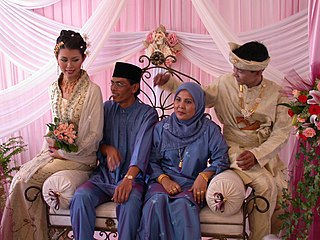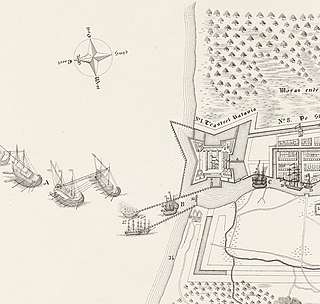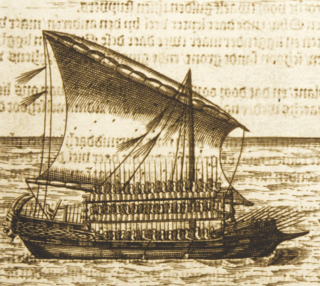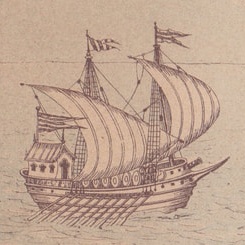
A navy, naval force, or maritime force is the branch of a nation's armed forces principally designated for naval and amphibious warfare; namely, lake-borne, riverine, littoral, or ocean-borne combat operations and related functions. It includes anything conducted by surface ships, amphibious ships, submarines, and seaborne aviation, as well as ancillary support, communications, training, and other fields. The strategic offensive role of a navy is projection of force into areas beyond a country's shores. The strategic defensive purpose of a navy is to frustrate seaborne projection-of-force by enemies. The strategic task of the navy also may incorporate nuclear deterrence by use of submarine-launched ballistic missiles. Naval operations can be broadly divided between riverine and littoral applications, open-ocean applications, and something in between, although these distinctions are more about strategic scope than tactical or operational division.

Majapahit, also known as Wilwatikta, was a Javanese Hindu-Buddhist thalassocratic empire in Southeast Asia that was based on the island of Java. It existed from 1293 to circa 1527 and reached its peak of glory during the era of Hayam Wuruk, whose reign from 1350 to 1389 was marked by conquests that extended throughout Southeast Asia. His achievement is also credited to his prime minister, Gajah Mada. According to the Nagarakretagama written in 1365, Majapahit was an empire of 98 tributaries, stretching from Sumatra to New Guinea; consisting of present-day Indonesia, Singapore, Malaysia, Brunei, southern Thailand, Timor Leste, southwestern Philippines although the scope of Majapahit sphere of influence is still the subject of debate among historians. The nature of Majapahit relations and influences upon its overseas vassals and also its status as an empire still provokes discussion.

Nusantara is the Indonesian name of Maritime Southeast Asia. It is an Old Javanese term that literally means "outer islands". In Indonesia, it is generally taken to mean the Indonesian Archipelago. Outside of Indonesia, the term has been adopted to refer the Malay Archipelago.

Malay Singaporeans are an umbrella term for the indigenous ethnic groups of Maritime Southeast Asia-origin who adhered to the religion of Islam and settled in Singapore. The Singaporean Malays constitute approximately 13.5% of the country's citizens, making them the second largest ethnic group in Singapore. Under the Constitution of Singapore, they are recognised by the government as the indigenous people of the country, with Malay as the ethnosocial language.

Tongkang or "Tong'kang" refers to several type of boats used to carry goods along rivers and shoreline in Maritime Southeast Asia. One of the earliest record of tongkang has a background of 14th century, being mentioned in Malay Annals which was composed no earlier than 17th century. One passage mentioned it as being used by Majapahit empire during the 1350 attack on Singapura.

A Borobudur ship is the 8th to 9th-century wooden double outrigger sailing vessel of Maritime Southeast Asia depicted in some bas reliefs of the Borobudur Buddhist monument in Central Java, Indonesia. It is a ship of Javanese people, derivative vessels of similar size still survived in East Java coastal trade at least until the 1940s.
This is a timeline of events in maritime history.

The Kingdom of Singapura was an Indianised Malay Hindu-Buddhist kingdom thought to have been established during the early history of Singapore upon its main island Pulau Ujong, then also known as Temasek, from 1299 until its fall sometime between 1396 and 1398. Conventional view marks c. 1299 as the founding year of the kingdom by Sang Nila Utama, whose father is Sang Sapurba, a semi-divine figure who according to legend is the ancestor of several Malay monarchs in the Malay World. The historicity of this kingdom based on the account given in the Malay Annals is uncertain, and many historians only consider its last ruler Parameswara a historically attested figure. Archaeological evidence from Fort Canning Hill and the nearby banks of the Singapore River has nevertheless demonstrated the existence of a thriving settlement and a trade port in the 14th century.

The military history of Indonesia includes the military history of the modern nation of Republic of Indonesia, as well as the military history of the states which preceded and formed it. It encompassed a kaleidoscope of conflicts spanning over a millennia. The ancient and medieval part of it began as tribal warfare began among indigenous populations, and escalated as kingdoms emerged. The modern part is defined by foreign colonial occupations, battles for independence through guerrilla warfare during Indonesian National Revolution, regional conquests and disputes with neighbouring countries, as well as battles between the Republic and separatist factions. Since the formation of the Republic, the military has played significant role in state affairs. However, in Post-Suharto era, the Indonesian military has retreated from politics, yet it still possesses some influences.
Cetbang were cannons produced and used by the Majapahit Empire (1293–1527) and other kingdoms in the Indonesian archipelago. There are 2 main types of cetbang: the eastern-style cetbang which looks like a Chinese cannon and is loaded from the front, and the western-style cetbang which is shaped like a Turkish and Portuguese cannon, loaded from the back.

A lancaran or lanchara is a type of sailing ship used in Maritime Southeast Asia. Although similar in shape to Mediterranean galleys, the lancaran was the backbone of the regional fleet of the western half of Nusantara before Mediterranean influence came. For their war fleet, the Malays prefer to use shallow draught, oared longships similar to the galley, such as lancaran, penjajap, and kelulus. This is very different from the Javanese who prefer long-range, deep-draught round ships such as jong and malangbang. The reason for this difference is that the Malays operated their ships in riverine water, sheltered straits zone, and archipelagic environment, while the Javanese are often active in the open and high sea. After contact with Iberian people, both the Javanese and Malay fleets began to use the ghurab and ghali more frequently.

The djong, jong, or jung is a type of sailing ship originating from Java, Indonesia that was widely used by Javanese, Sundanese, and later, also by Peguan and Malay sailors. The word was and is spelled jong in its languages of origin, the "djong" spelling being the colonial Dutch romanization. In English, the djong lends its name to other ships of similar configuration, called junks, and to their characteristic style of rigging, the junk rig.

Kelulus or kalulus is a type of rowing boat used in the Nusantara archipelago. It is typically small in size and propelled using oar or paddle. However, for long-distance voyages, this boat can be equipped with sails. It is not the same as prahu kalulis of the eastern part of the Indonesian archipelago.

Malangbang or melambang is a type of medieval sailing ship from Indonesia. It is mentioned mainly in the History of Banjar. The name "malangbang" is considered to originate from the Old Javanese language, malabong (malaboṅ) which refers to a particular type of boat. Malangbang is one of Majapahit's main naval vessel types after jong and kelulus. Not much is known about this type of ship, apart from the fact that it also used oar beside the sails to propel it, broad and flat-bottomed, and was a "medium-sized" ship, between the size of jong and kelulus, larger and faster than pilang (pelang).

Pelang or pilang is a traditional boat from Indonesia and Malaysia. It may refer to several different types of boats in the Nusantara, but commonly they refer to an outrigger canoe. The function differs from where they were used, from transporting people, fishing, to trading. Pilang has been known from at least the 14th century.

Ghurab or gurab is a type of merchant and warship from the Nusantara archipelago. The ship was a result of Mediterranean influences in the region, particularly introduced by the Arabs, Persians, and Ottomans. For their war fleet, the Malays prefer to use shallow draught, oared longships similar to the galley, such as lancaran, penjajap, and kelulus. This is very different from the Javanese who prefer long-range, deep-draught round ships such as jong and malangbang. The reason for this difference is that the Malays operated their ships in riverine water, sheltered straits zone, and archipelagic environment, while the Javanese are often active in the open and high sea. After contact with Iberian people, both the Javanese and Malay fleets began to use the ghurab and ghali more frequently.

Ghali, gali, or gale are a type of galley-like ships from the Nusantara archipelago. This type of ship only appeared after the 1530s. Before the appearance of this type of ship, several native galley-like ships already existed in the archipelago, some with outriggers. The design of ghali is the result of the impact made by Mediterranean shipbuilding techniques on native shipbuilding, introduced particularly by Arabs, Persians, Ottoman Turks, and Portuguese. The terms may also refer to Mediterranean vessels built by local people, or native vessels with Mediterranean influence.

A lancang is a type of sailing ship from Maritime Southeast Asia. It is used as warship, lighter, and as royal ship, particularly used by the people of Sumatran east coast, but can also be found in the coast of Kalimantan.
Cerucuh is an ancient, small Malay trading boat. One of the earliest record of cerucuh has a background of 14th century, being mentioned in Malay Annals which was composed no earlier than 17th century, being used by Majapahit empire during the first Majapahit attack on Singapura (1350). Malay Annals recorded:
Maka betara Majapahitpun menitahkan hulubalangnya berlengkap perahu akan menyerang Singapura itu, seratus buah jung; lain dari itu beberapa melangbing dan kelulus, jongkong, cerucuh, tongkang, tiada terhisabkan lagi banyaknya.
So the king of Majapahit ordered his war commander to equip vessels for attacking Singapore, a hundred jong; other than that a few melangbing and kelulus; jongkong, cerucuh, tongkang, all in uncountable numbers.

Mendam Berahi was a legendary royal galley said to have been used by the Malacca Sultanate in the early 16th century. This ship is fictional, recorded in the epic Hikayat Hang Tuah, and that type of ship, the ghali, did not exist until after the 1530s.

























